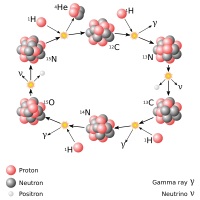Nuclear fusion reaction pathways
A variety of nuclear fusion reactions take place in the cores of stars, that depend upon their mass and composition. When nuclei fuse, the mass of the fused product is less than the mass of the original parts. This lost mass is converted to electromagnetic energy, according to the mass–energy equivalence relationship E = mc2.[3]
The hydrogen fusion process is temperature-sensitive, so a moderate increase in the core temperature will result in a significant increase in the fusion rate. As a result, the core temperature of main sequence stars only varies from 4 million kelvin for a small M-class star to 40 million kelvin for a massive O-class star.[141]
In the Sun, with a 10-million-kelvin core, hydrogen fuses to form helium in the proton–proton chain reaction:[169]
- 41H → 22H + 2e+ + 2νe(2 x 0.4 MeV)
- 2e+ + 2e− → 2γ (2 x 1.0 MeV)
- 21H + 22H → 23He + 2γ (2 x 5.5 MeV)
- 23He → 4He + 21H (12.9 MeV)
- 41H → 4He + 2e+ + 2γ + 2νe (26.7 MeV)
Element | Solar masses |
|---|---|
| Hydrogen | 0.01 |
| Helium | 0.4 |
| Carbon | 5[170] |
| Neon | 8 |
In evolved stars with cores at 100 million kelvin and masses between 0.5 and 10 M☉, helium can be transformed into carbon in the triple-alpha process that uses the intermediate element beryllium:[169]
For an overall reaction of:
- 34He → 12C + γ + 7.2 MeV
The example below shows the amount of time required for a star of 20 M☉ to consume all of its nuclear fuel. As an O-class main sequence star, it would be 8 times the solar radius and 62,000 times the Sun's luminosity.[171]
| Fuel material | Temperature (million kelvins) | Density (kg/cm3) | Burn duration (τ in years) |
|---|---|---|---|
| H | 37 | 0.0045 | 8.1 million |
| He | 188 | 0.97 | 1.2 million |
| C | 870 | 170 | 976 |
| Ne | 1,570 | 3,100 | 0.6 |
| O | 1,980 | 5,550 | 1.25 |
| S/Si | 3,340 | 33,400 | 0.0315[172] |



Walang komento:
Mag-post ng isang Komento